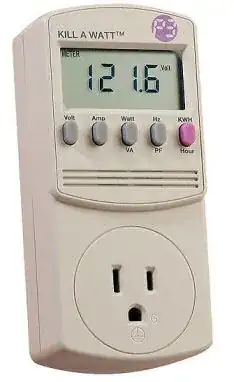It would be very, very hard to tell as so much of power consumption depends on the specifics of your server hardware.
That said, I highly recommend every sysadmin have a wattmeter in their toolkit, like the kill-a-watt.

(source: typepad.com)
Only twenty bucks and it makes this kind of stuff so easy to figure out!
For example, I learned that the web tier servers this very website is running on (Lenovo RS110, specs here), pull:
Idle: doing nothing at windows desktop (unusual, but depends on the server role.. some are light)
96w, 0.85 amp
Full New Install Windows Update: 20% on CPU, plus lots of disk activity (I would consider this more or less a typical load)
120w, 1.0 amp
Full Load: Prime95 + Update. 100% all 4 CPU cores, plus disk activity (this would be extraordinary load, rare)
175w, 1.55 amp
Of course you need to own the server to turn it on and use this tool on it, but perhaps you can use the tool on similar servers you already own to get an idea of what the power consumption might be of other servers you're planning to buy.
